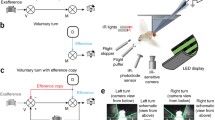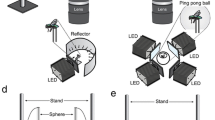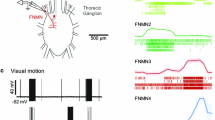Summary
Intracellular recording and Lucifer yellow dye filling of male fleshflies, Sarcophaga bullata, have revealed male-specific neurons in the lobula, the axons of which project to the origin of premotor channels supplying flight motor neurons. Dendrites of male-specific neurons visit areas of the retinotopic mosaic supplied by the retina's acute zone, which is used by males to keep the image of a conspecific female centered during aerial pursuit. Only males engage in high-speed acrobatic chases, and male-specific neurons are suspected to under-lie this behavior. Physiological determination of receptive fields of male-specific neurons substantiates the fields predicted from anatomical studies and demonstrates that they subtend the acute zone. Male-specific neurons respond in a manner predicted on theoretical grounds from observations of tracking behavior. Such properties include directional selectivity to visual motion and higher sensitivity to motion of small images than to wide-field motion. The present account substantiates and extends neuroanatomical evidence that predicts that male-specific lobula neurons comprise a distinct circuit mediating conspecific tracking.
Similar content being viewed by others
References
Beersma DGM, Stavenga DG, Kuiper JW (1975) Organization of visual axes in the compound eye of the fly Musca domestica L. and behavioral consequences. J Comp Physiol 102:305–320
Bennet-Clark HC, Ewing AW (1970) The love song of the fruit fly. Sci Am 223:84–92
Bishop L, Keehn DG, McCann GD (1968) Motion detection by interneurons of the optic lobes and brain of the flies Calliphora Phaenicia and Musca domestica. J Neurophysiol 31:509–525
Bülthoff H, Wehrhahn C (1984) Computation of motion and position in the visual system of the fly (Musca). Experiments with uniform stimulation. In: Varju D, Schnitzler H-U (eds) Locomotion and orientation in biology and engineering. Springer, Berlin Heidelberg New York, pp 149–152
Burkhardt D, de la Motte I (1983) How stalk-eyed flies eye stalkeyed flies: Observations and measurements of the eyes of Cyrtodiopsis whitei (Diopsidae, Diptera). J Comp Physiol 151:407–421
Collett TS (1980) Angular tracking and the optomotor response. An analysis of visual reflex interactions in a hoverfly. J Comp Physiol 140:145–158
Collett TS, Land MF (1975) Visual control of flight behavior in the hoverfly Syritta pipiens L. J Comp Physiol 99:1–66
Collett TS, Land MF (1978) How hoverflies compute interception courses. J Comp Physiol 125:191–204
Downes JA (1970) The feeding and mating behavior of the specialized Empidinae (Diptera); observations on four species of Rhamphomyia in the high Arctic and a general discussion. Canad Entomol 102:769–791
Egelhaaf M, Borst A (1989) Transient and steady-state response properties of movement detectors. J Optical Soc Am 6:116–127
Egelhaaf M, Borst A, Reichardt W (1989) Computational structure of a biological motion-detector system as revealed by local detector analysis in the fly's nervous system. J Optical Soc Am 6:1070–1087
Franceschini N (1975) Sampling of the visual environment by the compound eye of the fly: fundamentals and applications. In: Snyder AW, Menzel R (eds) Photoreceptor optics. Springer, Berlin Heidelberg New York, pp 98–125
Gibson JJ, Olum P, Rosenblatt F (1955) Parallax and perspective during aircraft landings. Am J Psychol 68:372–385
Gilbert C (1986) A morphological and cinematographic analysis of tiger beetle predatory behavior (Carabidae: Cicindelinae). In: den Boer PJ, Luff ML, Mossakowski D, Weber F (eds) Carabid beetles: Their adaptations and dynamics. G Fischer, Stuttgart, pp 43–57
Gilbert C, Penisten D, De Voe RD (1991) Discrimination of visual motion from flicker by identified neurons in the medulla of the freshfly Sarcophaga bullata. J Comp Physiol A 168:653–673
Gronenberg W, Strausfeld NJ (1991) Descending pathways connecting the male-specific visual system of flies to the neck and flight motor. J Comp Physiol A 169:413–426
Hardie R (1983) Projection and connectivity of sex-specific photoreceptors in the compound eye of the male housefly (Musca domestica.) Cell Tissue Res 233:1–21
Hardie R, Franceschini N, Ribi W, Kirschfeld K (1981) Distribution and properties of sex-specific photoreceptors in the fly Musca domestica. J Comp Physiol 145:139–152
Hausen K (1981) Monocular and binocular computation of motion in the lobula plate of the fly. Verh Dtsch Zool Ges 1981:49–70
Hausen K (1982) Motion sensitive interneurons in the optomotor system of the fly. II. The horizontal cells: Receptive field organization and response characteristics. Biol Cybern 46:67–79
Hausen K (1984) The lobula-complex of the fly: Structure function and significance in visual behavior. In: Ali MA (ed) Photoreception and vision in invertebrates. Plenum, New York, pp 523–559
Hausen K, Strausfeld NJ (1980) Sexually dimorphic interneuron arrangements in the fly visual system. Proc R Soc Lond B 208:57–71
Horridge GA (1978) The separation of visual axes in apposition compound eyes. Phil Trans R Soc Lond B 285:1–59
Kirschfeld K, Wenk P (1976) The dorsal compound eye of simuliid flies. Z Naturforsch 31c:764–765
Land MF (1975) Head movements and fly vision. In: Horridge GA (ed) The compound eye and insect vision. Clarendon Press, Oxford, UK pp 469–489
Land MF, Collett TS (1974) Chasing behavior of houseflies (Fannia canicularis). J Comp Physiol 89:331–357
Land MF, Eckert H (1985) Maps of the acute zones of fly eyes. J Comp Physiol A 156:525–538
Liske E, Mohren W (1984) Saccadic head movements of the praying mantis, with particular reference to visual and proprioceptive information. Physiol Entomol 9:29–38
O'Shea M, Adams M (1981) Pentapeptide (proctolin) associated with an identified neuron. Science 213:567–569
Pick B (1974) Visual flicker induces orientation behavior in the fly Musca. Z Naturforsch 29c:310–312
Reichardt W, Poggio T (1976) Visual control of orientation behavior in the fly. Q Rev Biophys 9:311–375
Robinson DA (1973) Models of the saccadic eye movement control system. Kybernetik 14:71–83
Robinson DA, Gordon JL, Gordon SE (1986) A model of the smooth pursuit eye movement system. Biol Cybern 55:43–57
Rossel S (1980) Foveal fixation and tracking in the praying mantis. J Comp Physiol 139:307–331
Rossel S (1983) Binocular stereopsis in an insect. Nature 302:821–822
Shaw S, Meinertzhagen I (1986) Evolutionary progression at synaptic connections made by identified homologous neurons. Proc Natl Acad Sci USA 83:7961–7965
Spurr A (1969) A low-viscosity epoxy resin embedding medium for electron microscopy. J Ultrastruct Res 26:31–43
Srinivasan MV, Bernard GD (1977) The pursuit response of the housefly and its interaction with the optomotor response. J Comp Physiol 115:101–117
Strausfeld NJ (1976) Atlas of an insect brain. Springer, Berlin Heidelberg New York
Strausfeld NJ (1980) Male and female visual neurones in dipterous insects. Nature 283:381–383
Strausfeld NJ (1984) Functional neuroanatomy of the blowfly's visual system. In: Ali MA (ed) Photoreception and vision in invertebrates. Plenum, New York, pp 483–522
Strausfeld NJ (1991) Structural organization of male-specific visual neurons in Calliphorid optic lobes. J Comp Physiol 169:379–393
Strausfeld NJ, Bassemir UK (1983) Cobalt-coupled neurons of a giant fibre system in Diptera. J Neurocytol 12:971–991
Strausfeld NJ, Gronenberg W (1990) Descending neurons supplying the neck and flight motor of Diptera: organization and neuroanatomical relationships with visual pathways. J Comp Neurol 302:954–972
Strausfeld NJ, Lee J-K (1991) Neuronal basis for parallel visual processing in the fly. Visual Neurosci 7:13–33
Strausfeld NJ, Seyan HS, Wohlers D, Bacon JP (1983) Lucifer yellow histology. In: Strausfeld NJ (ed) Functional neuroanatomy. Springer, Berlin Heidelberg New York, pp 132–155
Umeda K, Tateda H (1985) Visual interneurons in the lobula complex of the fleshfly, Boettcherisca peregrina. J Comp Physiol A 157:831–836
Vogel G (1957) Verhaltensphysiologische Untersuchungen über die den Weibchenbesprung des Stubenfliegen-Männchens (Musca domestica) auslösenden optischen Faktoren. Z Tierpsychol 14:309–323
Wagner H (1985) Aspects of the free-flight behaviour of houseflies (Musca domestica). In: Gewecke M, Wendler G (eds) Insect locomotion. Paul Parey, Berlin, pp 223–232
Wagner H (1986a) Flight performance and visual control of flight of the free-flying housefly (Musca domestica L.) I. Organization of the flight motor. Phil Trans R Soc Lond B 312:527–551
Wagner H (1986b) Flight performance and visual control of flight of the free-flying housefly (Musca domestica L.) II. Pursuit of targets. Phil Trans R Soc Lond B 312:553–579
Wehrhahn C (1979) Sex-specific differences in the chasing behavior of houseflies (Musca). Biol Cybern 32:239–241
Wehrhahn C, Poggio T, Bülthoff H (1982) Tracking and chasing in houseflies (Musca). Biol Cybern 45:123–130
Zeil J (1983a) Sexual dimorphism in the visual system of flies: The free flight behavior of male Bibionidae (Diptera). J Comp Physiol 150:395–412
Zeil J (1983b) Sexual dimorphism in the visual system of flies: The divided brain of male Bibionidae (Diptera). Cell Tissue Res 229:591–610
Author information
Authors and Affiliations
Rights and permissions
About this article
Cite this article
Gilbert, C., Strausfeld, N.J. The functional organization of male-specific visual neurons in flies. J Comp Physiol A 169, 395–411 (1991). https://doi.org/10.1007/BF00197653
Accepted:
Issue Date:
DOI: https://doi.org/10.1007/BF00197653




